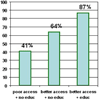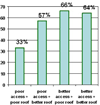Equity and vaccine uptake: a cross-sectional study of measles vaccination in Lasbela District, Pakistan
- PMID: 19828065
- PMCID: PMC3226239
- DOI: 10.1186/1472-698X-9-S1-S7
Equity and vaccine uptake: a cross-sectional study of measles vaccination in Lasbela District, Pakistan
Abstract
Background: Achieving equity means increased uptake of health services for those who need it most. But the poorest families continue to have the poorest service. In Pakistan, large numbers of children do not access vaccination against measles despite the national government's effort to achieve universal coverage.
Methods: A cross-sectional study of a random sample of 23 rural and 9 urban communities in the Lasbela district of south Pakistan, explored knowledge, attitudes and discussion around measles vaccination. Several socioeconomic variables allowed examination of the role of inequities in vaccination uptake; 2479 mothers provided information about 4007 children aged 10 to 59 months. A Mantel-Haenszel stratification analysis, with and without adjustment for clustering, clarified determinants of measles vaccination in urban and rural areas.
Results: A high proportion of mothers had appropriate knowledge of and positive attitudes to vaccination; many discussed vaccination, but only one half of children aged 10-59 months accessed vaccination. In urban areas, having an educated mother, discussing vaccinations, having correct knowledge about vaccinations, living in a community with a government vaccination facility within 5 km, and living in houses with better roofs were associated with vaccination uptake after adjusting for the effect of each of these variables and for clustering; maternal education was an equity factor even among those with good access. In rural areas, the combination of roof quality and access (vaccination post within 5 km) along with discussion about vaccines and knowledge about vaccines had an effect on uptake.
Conclusion: Stagnating rates of vaccination coverage may be related to increasing inequities. A hopeful finding is that discussion about vaccines and knowledge about vaccines had a positive effect that was independent of the negative effect of inequity - in both urban and rural areas. At least as a short term strategy, there seems to be reason to expect an intervention increasing knowledge and discussion about vaccination in this district might increase uptake.
Figures
References
-
- Heggenhougen HK. The epidemiology of inequity: Will research make a difference? Norsk Epidemiologi. 2005;15:127–132.
-
- The World Bank. World Development Report 2004. Making Services Work for Poor People. Washington. 2003.
-
- The World Bank. World Development Report 2006. Equity and Development, Washington. 2005.
LinkOut - more resources
Full Text Sources



